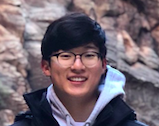Below is a summary of the abstract you submitted. Presenting author(s) is shown in bold.
If any changes need to be made, you can modify the abstract or change the authors.
You can also download a .docx version of this abstract.
If there are any problems, please email Dan at dar78@pitt.edu and he'll take care of them!
This abstract was last modified on May 2, 2019 at 8:22 p.m..

Students from La Sierra University isolated nineteen bacteriophages from several locations near Riverside, CA either through enrichment culture or direct plating. Fifteen of the phages were isolated from Microbacterium foliorum, and four from Gordonia rubripertincta.
Host range assays were performed on seven bacteriophages based on the results of preliminary experiments. The efficiency of plating was calculated for four related species of Microbacterium and two species of Gordonia. Plaquing efficiencies at different growth temperatures (25°C, 30°C, and 37°C) were also measured for each phage.
We selected two lytic Gordonia phages, CherryonLim and OhMyWard, for further investigation. Morphological analysis showed that both phages belong to the family Siphoviridae, which is characterized by a non-enveloped head, double-stranded DNA, and a non-contractile tail. Illumina sequencing was used to assign CherryonLim and OhMyWard into clusters CT and DJ, respectively. DNA Master and PECAAN were used to annotate each genome by assigning gene functions to putative ORFs.
CherryonLim is 48,948 base pairs long with 72 genes, making it the largest phage in its cluster. It also has a GC-content of 60.2%, and a 3’ single-strand extension of 13 bases. Phages in cluster CT are not known to have tRNAs and this is true for CherryonLim. OhMyWard has a genome length of 60,978 base pairs with 85 genes that are all in the forward direction, a GC-content of 52.2% and a 3’ single-strand extension of 9 bases. It is similar to other phages in cluster DJ, but interestingly it has the greatest number of orphams.

